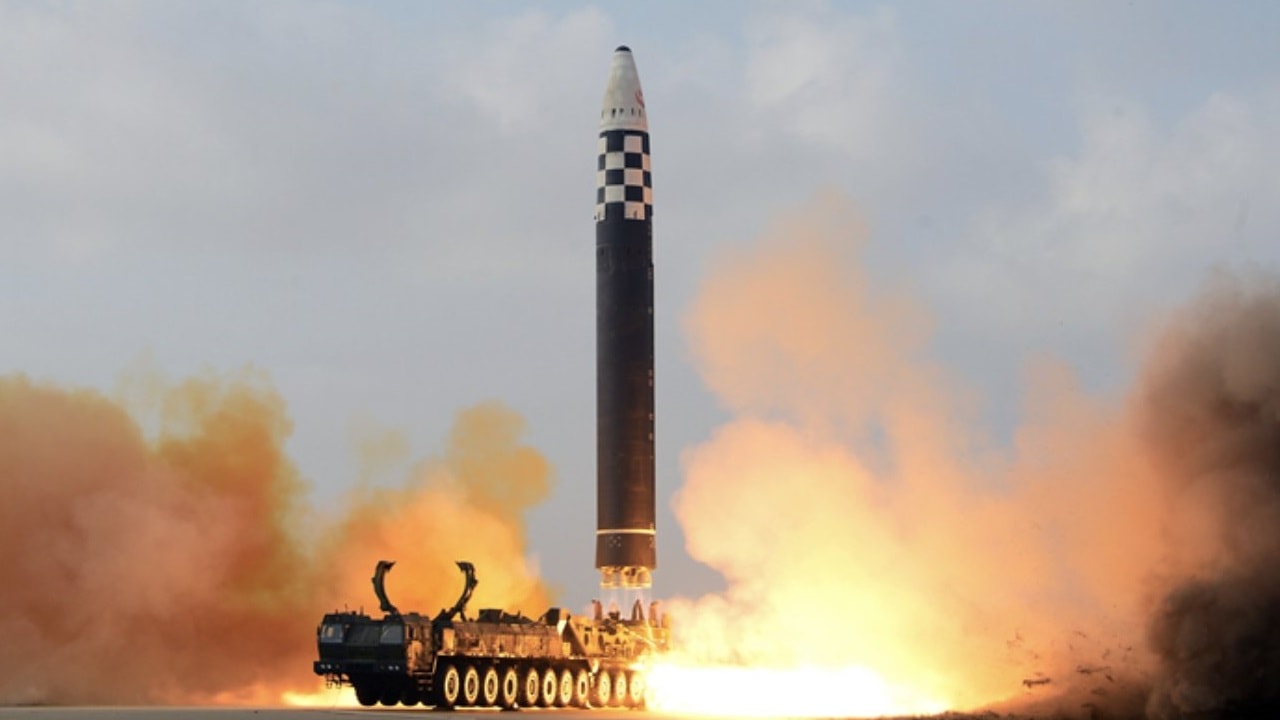Kim Yo-jong, the North Korean leader’s powerful sister, signaled that the regime may conduct a full-range ICBM flight to demonstrate unambiguously the survivability of its reentry vehicles carrying nuclear weapons. Such a launch would further inflame regional tensions and trigger strong allied responses. Pyongyang also harshly criticized Japan’s new national defense strategy, including Tokyo’s plans to develop counter-strike capabilities, and warned ominously of unspecified future actions.
(Subscribe to Our YouTube Channel Here)
On Dec. 18, North Korea launched two missiles to test its first military reconnaissance satellite’s ability to acquire and transmit imagery. The regime subsequently released low-resolution, black-and-white photos of Seoul and announced that preparations for an operational reconnaissance satellite will be complete by April 23, 2023.
South Korea disparaged the poor quality of the imagery, presumably shot during the tests. Kim Yo-jong, who serves as deputy director of the Korea Workers’ Party propaganda department, promptly sneered at Seoul’s criticism and emphasized the technical achievement of the test launch itself. Subsequent flights, she said, would use more capable and expensive cameras.
In January 2021, North Korean leader Kim Jong-un vowed to develop a reconnaissance satellite, along with solid-fuel, long-range missiles, and multi-warhead ICBMs. On Dec. 16, Pyongyang tested a static rocket engine that could serve as the booster for a solid-fuel ICBM.
Kim Yo-jong also bristled at expert assertions that North Korea has not yet proven its ICBM reentry vehicles can protect nuclear weapons from the intense heat of reentering the earth’s atmosphere on a parabolic trajectory. The CIA, however, assessed that Pyongyang’s ICBM reentry vehicles would likely perform adequately if flown on a normal trajectory to attack U.S. targets.
To date, North Korea has launched all of its ICBMs on high-angle, lofted trajectories so as to not fly over neighboring countries. The 6,000-kilometer apogee of the Hwasong-15/17 flights is assessed as enabling the missiles to reach anywhere in the continental United States.
North Korea has launched a record-high number of missiles this year. In October, Pyongyang flew a Hwasong-12 intermediate-range ballistic missile over Japan for the first time since 2017. The regime also resumed ICBM launches after a five-year hiatus. Kim’s vitriolic remarks against those questioning North Korea’s capabilities suggest the regime may conduct a full-range ICBM test over Japan and into the Pacific Ocean.
The regime would also be motivated to fly a missile over Japan to signal its displeasure with Tokyo’s new national security policy. On Dec. 16, Prime Minister Fumio Kishida released Japan’s new national security and defense strategies, which expressed Japan’s intention to develop its first-ever counter-strike policy using long-range missiles. Tokyo previously interpreted its peace constitution as precluding offensive capabilities.
North Korea characterized the counter-strike policy as rearmament of the “war criminal state [and] a wanton violation of the UN Charter and serious challenge to the international peace and stability.” The regime declared it could take a “resolute and decisive military step” to defend its sovereignty and warned Tokyo of a “shudder to be felt soon.”
Pyongyang’s latest comments follow several months of high-level North Korean and allied military actions. The U.S., South Korea, and Japan resumed large-scale military exercises after a four-year lull which triggered extensive North Korean military activity close to the inter-Korean border. After North Korea’s reconnaissance missile launch, the U.S. and South Korea flew nuclear-capable B-52 bombers and the F-22 stealth fighter jets in combined military drills with South Korean warplanes near the Korean Peninsula.
In September, North Korea passed a new law codifying its nuclear doctrine. Pyongyang declared that nuclear weapons would be used in response to, or perceived preparations for, any nuclear or non-nuclear attack by the United States or its allies on regime leadership, nuclear command structure, or important strategic targets.
Washington and its allies pledged a resolute response to any additional North Korean military provocations, such as a nuclear test or ICBM flight. Options include an even higher tempo of rotational deployments of U.S. nuclear-capable strategic assets to the Korean Peninsula. North Korea would likely respond with additional provocative actions raising the risk of inadvertent military clashes.
MORE: Putin Will Flip – Ukraine Is Getting Patriot Missiles
MORE: Could India and China Be Headed for War?
MORE: Can a Coup Takedown Putin for Good?
Author Expertise and Experience: Bruce Klingner specializes in Korean and Japanese affairs as the senior research fellow for Northeast Asia at The Heritage Foundation’s Asian Studies Center. Klingner’s analysis and writing about North Korea, South Korea and Japan, as well as related issues, are informed by his 20 years of service at the Central Intelligence Agency and the Defense Intelligence Agency. Klingner, who joined Heritage in 2007, has testified before the House Foreign Affairs Committee, the Senate Select Committee on Intelligence and the House Permanent Select Committee on Intelligence.

